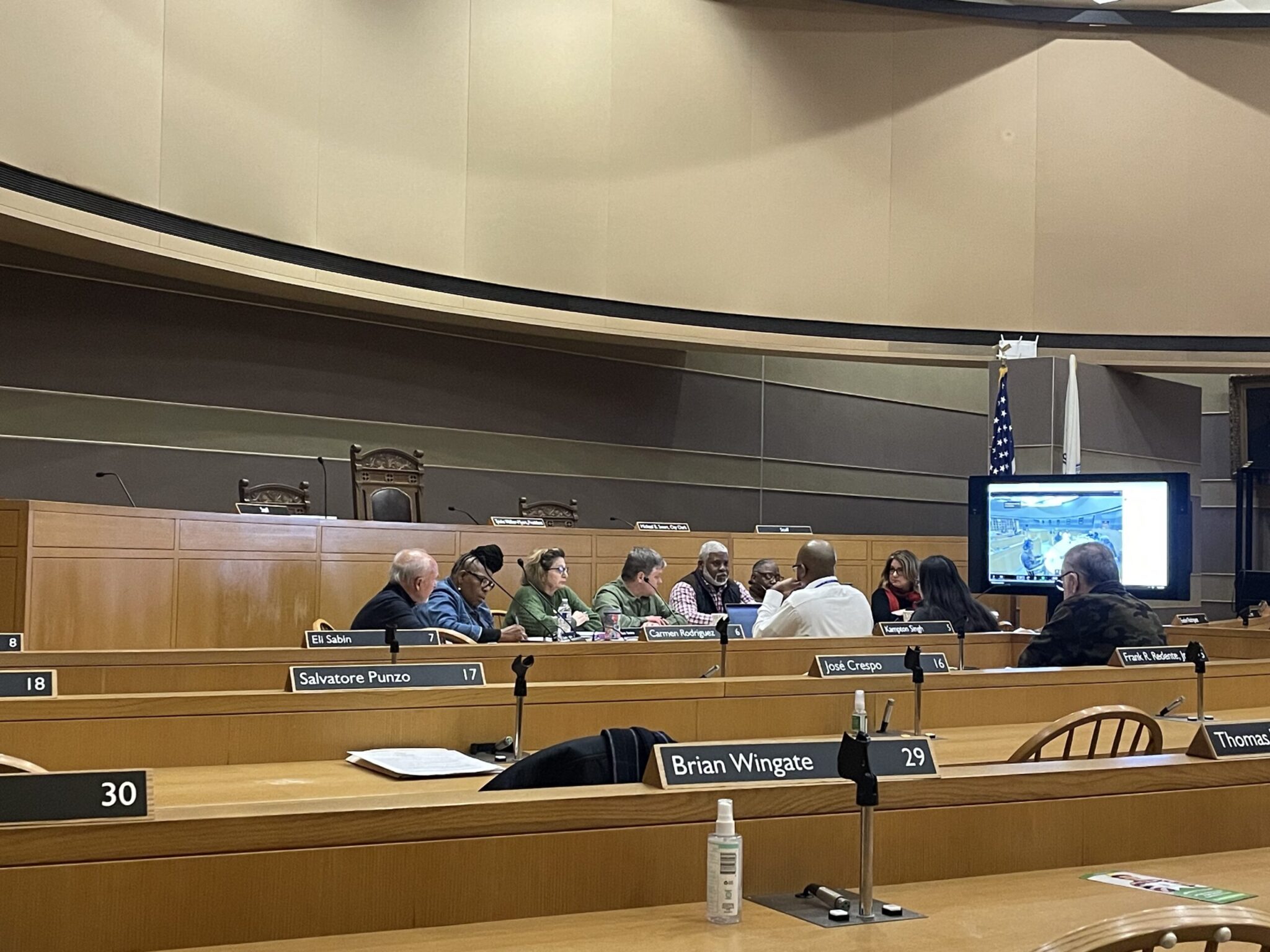Environmental policy hearing urges new city priorities: pesticides, artificial turf, electrification
Environmental policy hearing urges new city priorities: pesticides, artificial turf, electrification Yale Daily News


Climate Advocates Testify on Pesticides and Electrification at New Haven Board of Alders Meeting

Ariela Lopez, Contributing Photographer
Introduction
Climate advocates testified on the dangers of pesticides and the benefits of electrification at the Board of Alders’ community services and environmental policy committee meeting on Thursday.
Lawn Pesticides and Artificial Turf
The committee held a public hearing to discuss lawn pesticides and artificial turf. Laura Cahn, the chair of the city’s Environmental Advisory Committee, presented on pesticides and urged the city to rethink its system of licensing officials that use pesticides. New Haven Climate Movement representative Krishna Davis ’25 and Steve Winter, New Haven’s Office of Climate and Sustainability director, testified about electrification.
Sustainable Development Goals (SDGs)
- Goal 15: Life on Land – Advocacy for alternatives to pesticides and the preservation of natural environments.
- Goal 7: Affordable and Clean Energy – Promotion of electrification as a sustainable energy solution.
Pesticide Use and Alternatives
- Cahn highlighted the continued use of pesticides on lawns in spite of a previous resolution implementing a “voluntary ban” on lawn chemicals.
- She suggested using goats as an alternative to chemicals for invasive plant control, citing the success of a previous goat project in Edgewood Park.
- Cahn also raised concerns about the potential spread of pesticide toxins by leaf blowers.
Artificial Turf and its Maintenance
- Cahn warned about the dangers of artificial turf, which requires pesticides for maintenance.
- Artificial turf is widely used for athletic fields throughout the city.
Electrification Goals and Progress
- Krishna Davis ’25 spoke on behalf of the New Haven Climate Movement’s Electric Future Committee about the city’s progress towards meeting electrification goals.
- Davis called for incentivizing developers to use electric sources of energy and report their carbon emissions.
- He highlighted the need for more electric construction projects in New Haven, citing examples from other cities like Ithaca, New York.
Progress in Electrification Efforts
- The city has worked to electrify its light fleet, purchasing Chevrolet Volts for city officials to use.
- New Haven will receive financial incentives from the federal government for purchasing electric vehicles.
- The Office of Climate and Sustainability has been collaborating with The City Plan Department to incentivize all-electric developments through zoning language and density bonuses.
- Efforts have also been made to replace gas heating systems with heat pumps in community centers, youth recreation centers, and senior centers.
Conclusion
The meeting highlighted the importance of addressing pesticide use and promoting electrification to achieve the Sustainable Development Goals. Advocates urged the city to take action and prioritize sustainable practices for a healthier and more environmentally friendly future.
SDGs, Targets, and Indicators Analysis
1. Which SDGs are addressed or connected to the issues highlighted in the article?
- SDG 3: Good Health and Well-being
- SDG 11: Sustainable Cities and Communities
- SDG 13: Climate Action
- SDG 15: Life on Land
The article discusses the dangers of pesticides and the benefits of electrification, which are connected to SDG 3 (improving health and well-being) as pesticides can have harmful effects on human health. The article also addresses SDG 11 (sustainable cities and communities) as it discusses the city’s progress in implementing the New Haven Community Electrification Resolution. Additionally, the article relates to SDG 13 (climate action) as it highlights the importance of electrification in reducing greenhouse gas emissions. Finally, the article touches on SDG 15 (life on land) as it discusses the use of goats to control invasive plant growth in parks.
2. What specific targets under those SDGs can be identified based on the article’s content?
- Target 3.9: By 2030, substantially reduce the number of deaths and illnesses from hazardous chemicals and air, water, and soil pollution and contamination.
- Target 11.6: By 2030, reduce the adverse per capita environmental impact of cities, including by paying special attention to air quality and municipal and other waste management.
- Target 13.2: Integrate climate change measures into national policies, strategies, and planning.
- Target 15.5: Take urgent and significant action to reduce the degradation of natural habitats, halt the loss of biodiversity, and protect and prevent the extinction of threatened species.
Based on the article’s content, the targets identified are relevant to the issues discussed. Target 3.9 focuses on reducing the negative health impacts of hazardous chemicals, including pesticides. Target 11.6 aims to reduce the environmental impact of cities, including air pollution and waste management, which can be addressed through electrification and reducing pesticide use. Target 13.2 emphasizes integrating climate change measures into policies and planning, which aligns with the city’s efforts towards electrification. Target 15.5 highlights the need to protect natural habitats and prevent biodiversity loss, which can be achieved by controlling invasive plant growth through alternative methods like using goats.
3. Are there any indicators mentioned or implied in the article that can be used to measure progress towards the identified targets?
- Indicator: Number of deaths and illnesses related to hazardous chemicals and pollution.
- Indicator: Air quality index in cities.
- Indicator: Percentage reduction in greenhouse gas emissions from electrification efforts.
- Indicator: Area of natural habitats protected or restored.
The article does not explicitly mention specific indicators, but the identified targets can be measured using these indicators. The number of deaths and illnesses related to hazardous chemicals and pollution can be used to measure progress towards Target 3.9. The air quality index in cities can indicate progress towards Target 11.6. The percentage reduction in greenhouse gas emissions resulting from electrification efforts can be used to measure progress towards Target 13.2. Finally, the area of natural habitats protected or restored can indicate progress towards Target 15.5.
4. Table: SDGs, Targets, and Indicators
| SDGs | Targets | Indicators |
|---|---|---|
| SDG 3: Good Health and Well-being | Target 3.9: By 2030, substantially reduce the number of deaths and illnesses from hazardous chemicals and air, water, and soil pollution and contamination. | Number of deaths and illnesses related to hazardous chemicals and pollution. |
| SDG 11: Sustainable Cities and Communities | Target 11.6: By 2030, reduce the adverse per capita environmental impact of cities, including by paying special attention to air quality and municipal and other waste management. | Air quality index in cities. |
| SDG 13: Climate Action | Target 13.2: Integrate climate change measures into national policies, strategies, and planning. | Percentage reduction in greenhouse gas emissions from electrification efforts. |
| SDG 15: Life on Land | Target 15.5: Take urgent and significant action to reduce the degradation of natural habitats, halt the loss of biodiversity, and protect and prevent the extinction of threatened species. | Area of natural habitats protected or restored. |
Behold! This splendid article springs forth from the wellspring of knowledge, shaped by a wondrous proprietary AI technology that delved into a vast ocean of data, illuminating the path towards the Sustainable Development Goals. Remember that all rights are reserved by SDG Investors LLC, empowering us to champion progress together.
Source: yaledailynews.com

Join us, as fellow seekers of change, on a transformative journey at https://sdgtalks.ai/welcome, where you can become a member and actively contribute to shaping a brighter future.







